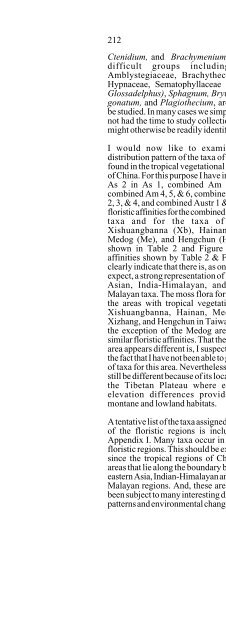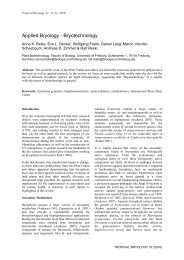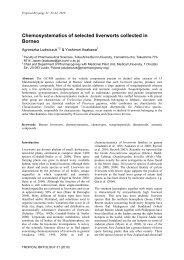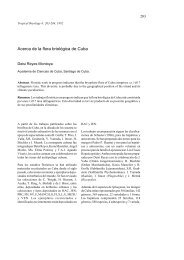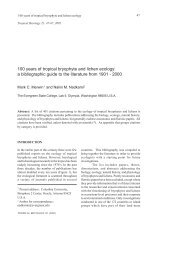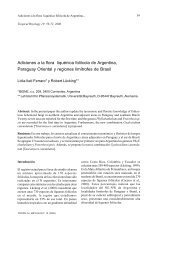Tropical component of the Moss Flora of China
Tropical component of the Moss Flora of China
Tropical component of the Moss Flora of China
Create successful ePaper yourself
Turn your PDF publications into a flip-book with our unique Google optimized e-Paper software.
212<br />
Ctenidium, and Brachymenium. Many<br />
difficult groups including <strong>the</strong><br />
Amblystegiaceae, Brachy<strong>the</strong>ciaceae,<br />
Hypnaceae, Sematophyllaceae (except<br />
Glossadelphus), Sphagnum, Bryum, Pogonatum,<br />
and Plagio<strong>the</strong>cium, are yet to<br />
be studied. In many cases we simply have<br />
not had <strong>the</strong> time to study collections that<br />
might o<strong>the</strong>rwise be readily identified.<br />
I would now like to examine <strong>the</strong><br />
distribution pattern <strong>of</strong> <strong>the</strong> taxa <strong>of</strong> mosses<br />
found in <strong>the</strong> tropical vegetational regions<br />
<strong>of</strong> <strong>China</strong>. For this purpose I have included<br />
As 2 in As 1, combined Am 2 & 3,<br />
combined Am 4, 5, & 6, combined Afr 1,<br />
2, 3, & 4, and combined Austr 1 & 2. The<br />
floristic affinities for <strong>the</strong> combined tropical<br />
taxa and for <strong>the</strong> taxa <strong>of</strong> each,<br />
Xishuangbanna (Xb), Hainan (Ha),<br />
Medog (Me), and Hengchun (He), are<br />
shown in Table 2 and Figure 2. The<br />
affinities shown by Table 2 & Figure 2<br />
clearly indicate that <strong>the</strong>re is, as one might<br />
expect, a strong representation <strong>of</strong> Eastern<br />
Asian, India-Himalayan, and Indo-<br />
Malayan taxa. The moss flora for each <strong>of</strong><br />
<strong>the</strong> areas with tropical vegetation, i.e.<br />
Xishuangbanna, Hainan, Medog in<br />
Xizhang, and Hengchun in Taiwan, with<br />
<strong>the</strong> exception <strong>of</strong> <strong>the</strong> Medog area, have<br />
similar floristic affinities. That <strong>the</strong> Medog<br />
area appears different is, I suspect, due to<br />
<strong>the</strong> fact that I have not been able to get a list<br />
<strong>of</strong> taxa for this area. Never<strong>the</strong>less, it may<br />
still be different because <strong>of</strong> its location on<br />
<strong>the</strong> Tibetan Plateau where extreme<br />
elevation differences provide both<br />
montane and lowland habitats.<br />
A tentative list <strong>of</strong> <strong>the</strong> taxa assigned to each<br />
<strong>of</strong> <strong>the</strong> floristic regions is included in<br />
Appendix I. Many taxa occur in several<br />
floristic regions. This should be expected<br />
since <strong>the</strong> tropical regions <strong>of</strong> <strong>China</strong> are<br />
areas that lie along <strong>the</strong> boundary between<br />
eastern Asia, Indian-Himalayan and Indo-<br />
Malayan regions. And, <strong>the</strong>se areas have<br />
been subject to many interesting dispersal<br />
patterns and environmental changes. First<br />
and foremost, one must consider <strong>the</strong><br />
consequence <strong>of</strong> <strong>the</strong> Indian plate as it drifted<br />
northward and collided with <strong>the</strong> Laurasian<br />
plate forcing <strong>the</strong> uplift <strong>of</strong> <strong>the</strong> Himalayan<br />
mountains. Not only did this tectonic event<br />
result in <strong>the</strong> possible rafting <strong>of</strong> Gonwanna<br />
taxa into sou<strong>the</strong>rn Laurasia (Schuster<br />
1983), but <strong>the</strong> tremendous elevation<br />
changes that developed in <strong>the</strong> sou<strong>the</strong>rn<br />
part <strong>of</strong> Laurasia also influenced major<br />
wea<strong>the</strong>r patterns in Sou<strong>the</strong>ast Asia. Strong<br />
easterly air flow created <strong>the</strong> monsoon conditions<br />
necessary for <strong>the</strong> development <strong>of</strong><br />
<strong>the</strong> tropical rainforests (Chang 1983). Fur<strong>the</strong>rmore,<br />
such a strong easterly air flow<br />
was probably <strong>the</strong> vector for long range<br />
dispersal <strong>of</strong> bryophytes to Sou<strong>the</strong>ast Asia<br />
and to <strong>the</strong> oceanic islands in <strong>the</strong> Pacific.<br />
Add to all this <strong>the</strong> influence <strong>of</strong> <strong>the</strong> Arcto-<br />
Tertiary events that established remarkable<br />
relationships between eastern North<br />
America and eastern Asia, and <strong>the</strong><br />
migration patterns stimulated by <strong>the</strong><br />
Pleistocene and it is understandable why<br />
<strong>the</strong> mosses <strong>of</strong> <strong>the</strong> Chinese tropics have<br />
such diverse geographic affinities.<br />
The large number <strong>of</strong> endemic species<br />
reported from <strong>the</strong> Medog region <strong>of</strong> Xizang<br />
is noteworthy. This may be <strong>the</strong> result <strong>of</strong><br />
<strong>the</strong> topographic diversity and isolation <strong>of</strong><br />
<strong>the</strong> region that have combined to produce<br />
both 'biotic islands' and 'stress', conditions<br />
that promote rapid speciation (Schuster<br />
1983).<br />
The islands <strong>of</strong> Hainan and Taiwan are<br />
considered continental. In <strong>the</strong> case <strong>of</strong><br />
Hainan, <strong>the</strong> floristic affinities seems to be<br />
equally divided between eastern Asiatic,<br />
India-Himalayan, and Indomalayan<br />
(Figure 2). Wu & Lou (1978) noted that<br />
<strong>the</strong> same floristic elements exist for <strong>the</strong><br />
Hepaticae. On <strong>the</strong> o<strong>the</strong>rhand, <strong>the</strong> floristic<br />
affinities <strong>of</strong> Hengchun on Taiwan, based<br />
on acrocarpous mosses, has a weaker representation<br />
<strong>of</strong> India-Himalayan and<br />
Indomalayan taxa than Hainan. Similar<br />
conclusions were reached by Wang (1970)<br />
in his monumental study <strong>of</strong> <strong>the</strong>


